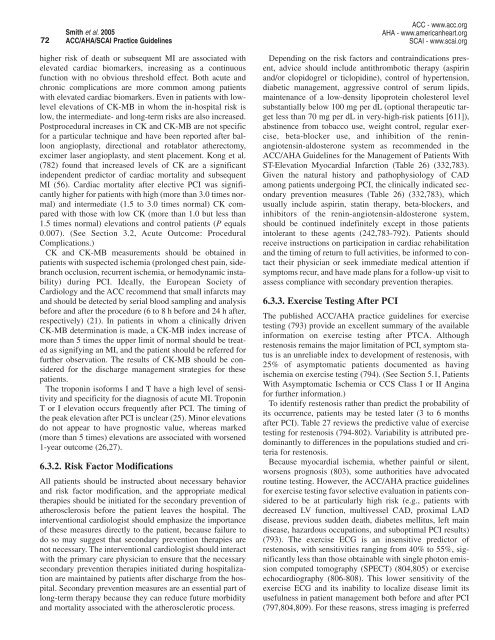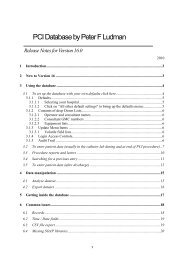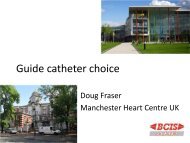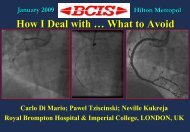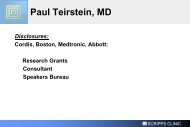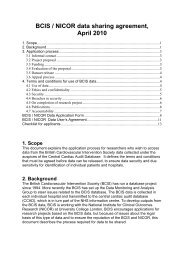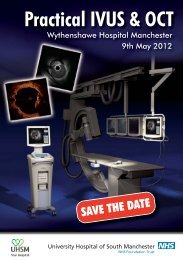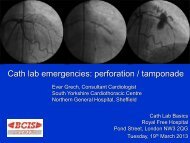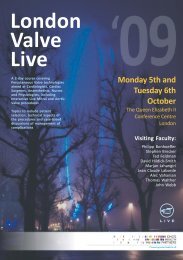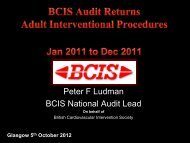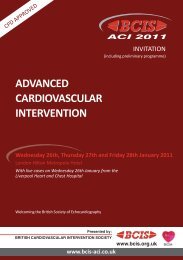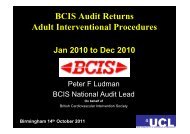Recommendations
ACC/AHA/SCAI PCI Guidelines - British Cardiovascular Intervention ...
ACC/AHA/SCAI PCI Guidelines - British Cardiovascular Intervention ...
- No tags were found...
Create successful ePaper yourself
Turn your PDF publications into a flip-book with our unique Google optimized e-Paper software.
72<br />
Smith et al. 2005<br />
ACC/AHA/SCAI Practice Guidelines<br />
ACC - www.acc.org<br />
AHA - www.americanheart.org<br />
SCAI - www.scai.org<br />
higher risk of death or subsequent MI are associated with<br />
elevated cardiac biomarkers, increasing as a continuous<br />
function with no obvious threshold effect. Both acute and<br />
chronic complications are more common among patients<br />
with elevated cardiac biomarkers. Even in patients with lowlevel<br />
elevations of CK-MB in whom the in-hospital risk is<br />
low, the intermediate- and long-term risks are also increased.<br />
Postprocedural increases in CK and CK-MB are not specific<br />
for a particular technique and have been reported after balloon<br />
angioplasty, directional and rotablator atherectomy,<br />
excimer laser angioplasty, and stent placement. Kong et al.<br />
(782) found that increased levels of CK are a significant<br />
independent predictor of cardiac mortality and subsequent<br />
MI (56). Cardiac mortality after elective PCI was significantly<br />
higher for patients with high (more than 3.0 times normal)<br />
and intermediate (1.5 to 3.0 times normal) CK compared<br />
with those with low CK (more than 1.0 but less than<br />
1.5 times normal) elevations and control patients (P equals<br />
0.007). (See Section 3.2, Acute Outcome: Procedural<br />
Complications.)<br />
CK and CK-MB measurements should be obtained in<br />
patients with suspected ischemia (prolonged chest pain, sidebranch<br />
occlusion, recurrent ischemia, or hemodynamic instability)<br />
during PCI. Ideally, the European Society of<br />
Cardiology and the ACC recommend that small infarcts may<br />
and should be detected by serial blood sampling and analysis<br />
before and after the procedure (6 to 8 h before and 24 h after,<br />
respectively) (21). In patients in whom a clinically driven<br />
CK-MB determination is made, a CK-MB index increase of<br />
more than 5 times the upper limit of normal should be treated<br />
as signifying an MI, and the patient should be referred for<br />
further observation. The results of CK-MB should be considered<br />
for the discharge management strategies for these<br />
patients.<br />
The troponin isoforms I and T have a high level of sensitivity<br />
and specificity for the diagnosis of acute MI. Troponin<br />
T or I elevation occurs frequently after PCI. The timing of<br />
the peak elevation after PCI is unclear (25). Minor elevations<br />
do not appear to have prognostic value, whereas marked<br />
(more than 5 times) elevations are associated with worsened<br />
1-year outcome (26,27).<br />
6.3.2. Risk Factor Modifications<br />
All patients should be instructed about necessary behavior<br />
and risk factor modification, and the appropriate medical<br />
therapies should be initiated for the secondary prevention of<br />
atherosclerosis before the patient leaves the hospital. The<br />
interventional cardiologist should emphasize the importance<br />
of these measures directly to the patient, because failure to<br />
do so may suggest that secondary prevention therapies are<br />
not necessary. The interventional cardiologist should interact<br />
with the primary care physician to ensure that the necessary<br />
secondary prevention therapies initiated during hospitalization<br />
are maintained by patients after discharge from the hospital.<br />
Secondary prevention measures are an essential part of<br />
long-term therapy because they can reduce future morbidity<br />
and mortality associated with the atherosclerotic process.<br />
Depending on the risk factors and contraindications present,<br />
advice should include antithrombotic therapy (aspirin<br />
and/or clopidogrel or ticlopidine), control of hypertension,<br />
diabetic management, aggressive control of serum lipids,<br />
maintenance of a low-density lipoprotein cholesterol level<br />
substantially below 100 mg per dL (optional therapeutic target<br />
less than 70 mg per dL in very-high-risk patients [611]),<br />
abstinence from tobacco use, weight control, regular exercise,<br />
beta-blocker use, and inhibition of the reninangiotensin-aldosterone<br />
system as recommended in the<br />
ACC/AHA Guidelines for the Management of Patients With<br />
ST-Elevation Myocardial Infarction (Table 26) (332,783).<br />
Given the natural history and pathophysiology of CAD<br />
among patients undergoing PCI, the clinically indicated secondary<br />
prevention measures (Table 26) (332,783), which<br />
usually include aspirin, statin therapy, beta-blockers, and<br />
inhibitors of the renin-angiotensin-aldosterone system,<br />
should be continued indefinitely except in those patients<br />
intolerant to these agents (242,783-792). Patients should<br />
receive instructions on participation in cardiac rehabilitation<br />
and the timing of return to full activities, be informed to contact<br />
their physician or seek immediate medical attention if<br />
symptoms recur, and have made plans for a follow-up visit to<br />
assess compliance with secondary prevention therapies.<br />
6.3.3. Exercise Testing After PCI<br />
The published ACC/AHA practice guidelines for exercise<br />
testing (793) provide an excellent summary of the available<br />
information on exercise testing after PTCA. Although<br />
restenosis remains the major limitation of PCI, symptom status<br />
is an unreliable index to development of restenosis, with<br />
25% of asymptomatic patients documented as having<br />
ischemia on exercise testing (794). (See Section 5.1, Patients<br />
With Asymptomatic Ischemia or CCS Class I or II Angina<br />
for further information.)<br />
To identify restenosis rather than predict the probability of<br />
its occurrence, patients may be tested later (3 to 6 months<br />
after PCI). Table 27 reviews the predictive value of exercise<br />
testing for restenosis (794-802). Variability is attributed predominantly<br />
to differences in the populations studied and criteria<br />
for restenosis.<br />
Because myocardial ischemia, whether painful or silent,<br />
worsens prognosis (803), some authorities have advocated<br />
routine testing. However, the ACC/AHA practice guidelines<br />
for exercise testing favor selective evaluation in patients considered<br />
to be at particularly high risk (e.g., patients with<br />
decreased LV function, multivessel CAD, proximal LAD<br />
disease, previous sudden death, diabetes mellitus, left main<br />
disease, hazardous occupations, and suboptimal PCI results)<br />
(793). The exercise ECG is an insensitive predictor of<br />
restenosis, with sensitivities ranging from 40% to 55%, significantly<br />
less than those obtainable with single photon emission<br />
computed tomography (SPECT) (804,805) or exercise<br />
echocardiography (806-808). This lower sensitivity of the<br />
exercise ECG and its inability to localize disease limit its<br />
usefulness in patient management both before and after PCI<br />
(797,804,809). For these reasons, stress imaging is preferred


